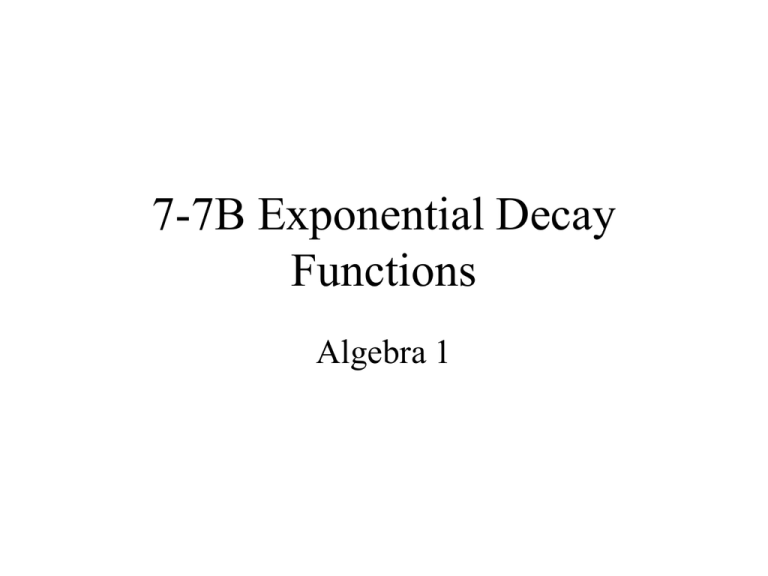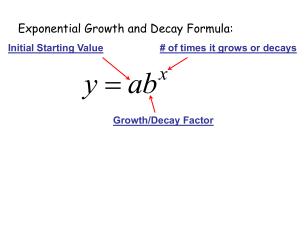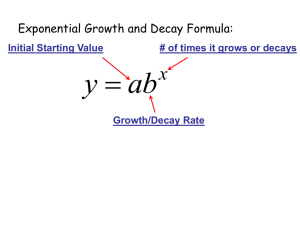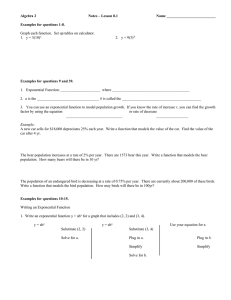7-7B
advertisement

7-7B Exponential Decay Functions Algebra 1 Exponential Decay y a b x a is the initial amount b is the decay factor y-intercept is (0,a) Where a>0 & 0 < b< 1 WRITING EXPONENTIAL DECAY MODELS A quantity is decreasing exponentially if it decreases by the same percent in each time period. EXPONENTIAL DECAY MODEL C is the initial amount. t is the time period. y = C (1 – r)t (1 – r ) is the decay factor, r is the decay rate. The percent of decrease is 100r. Ex. 1)Identify the initial amount a & the decay factor b in each exponential function. • f(x) = 10 0.1x Ex. 2 State whether the equation represents exponential growth, exponential decay or neither y 0.93 2 y 7 0.5 x x Ex. 3 • You bought a used boat for $2300. The value of the boat will be less each year because of depreciation. The boat depreciates at the rate of 8% per year. • A.) Write an exponential decay model to represent this situation. Ex. 3 ( Cont.’d) • You bought a used boat for $2300. The value of the boat will be less each year because of depreciation. The boat depreciates at the rate of 8% per year. • B.) Estimate the value of the boat in 2 years. Example 4 • You bought a computer for $1800. The value of the computer will be less each year because of depreciation. The computer depreciates at the rate of 29% per year. • a.) Write an exponential decay model to represent this situation. Example 4 (Cont.’d) • You bought a computer for $1800. The value of the computer will be less each year because of depreciation. The computer depreciates at the rate of 29% per year. • b.) Estimate the value of the computer in 3 years. Assignment • GRAPHING EXPONENTIAL DECAY MODELS CONCEPT EXPONENTIAL GROWTH AND DECAY MODELS SUMMARY EXPONENTIAL GROWTH MODEL y = C (1 + r)t EXPONENTIAL DECAY MODEL y = C (1 – r)t An exponential model y = a • b t represents exponential b > 1 and exponential (1 decay 0 <decay b < 1.factor, (1 growth + r) is theifgrowth factor, – r) isifthe Ct is is the the initial time period. amount. C) (0, C) rate. r is the(0,growth rate. r is the decay 1+r>1 0<1–r<1 Writing an Exponential Decay Model From 1982 through 1997, the purchasing power of a dollar decreased by about 3.5% per year. Using 1982 as the base for comparison, what was the purchasing power of a dollar in 1997? COMPOUND INTEREST SOLUTION Let y represent the purchasing power and let t = 0 represent the year 1982. The initial amount is $1. Use an exponential decay model. y = C(1 – r) t Exponential decay model = (1)(1 – 0.035) t Substitute 1 for C, 0.035 for r. = 0.965 t Simplify. Because 1997 is 15 years after 1982, substitute 15 for t. y = 0.96515 Substitute 15 for t. 0.59 The purchasing power of a dollar in 1997 compared to 1982 was $0.59. GRAPHING EXPONENTIAL DECAY MODELS Graphing the Decay of Purchasing Power Graph the exponential decay model in the previous example. Use the graph to estimate the value of a dollar in ten years. SOLUTION Help Make a table of values, plot the points in a coordinate plane, and draw a smooth curve through the points. t 0 1 2 3 4 5 6 7 8 9 10 y 1.00 0.965 0.931 0.899 0.867 0.837 0.808 0.779 0.752 0.726 0.7 y = 0.965t 0.8 (dollars) Purchasing Power 1.0 0.6 0.4 0.2 0 1 2 3 Your dollar of today will be worth about 70 cents in ten years. 4 5 6 7 8 Years From Now 9 10 11 12






